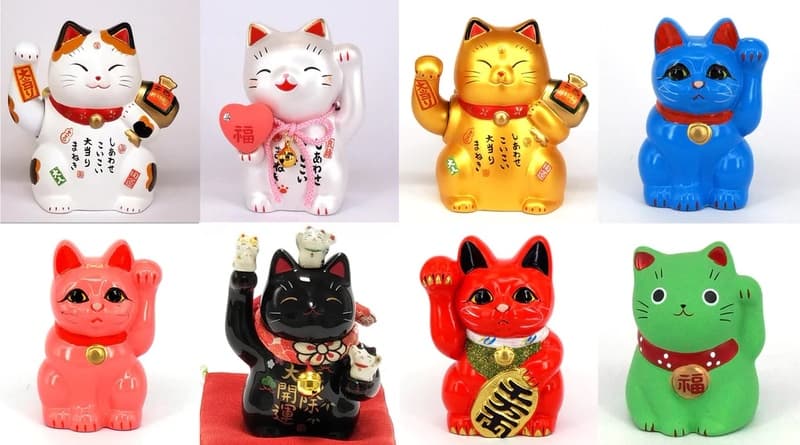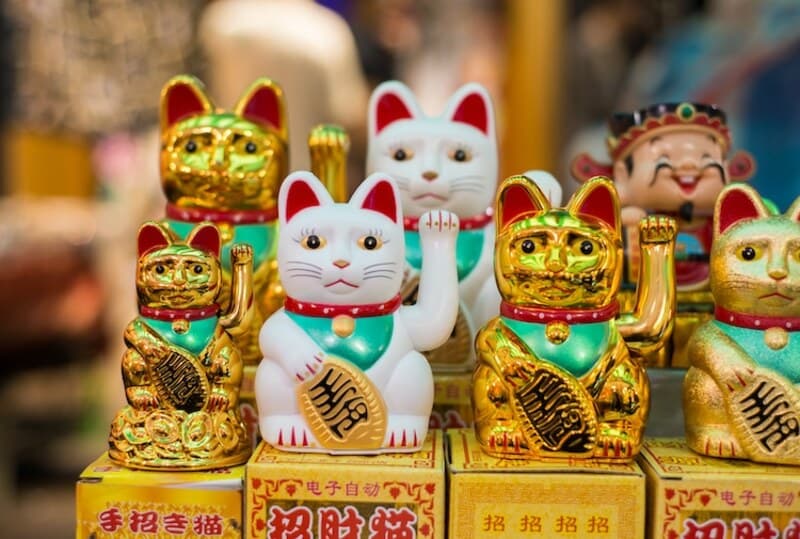Whether you’re at a Chinatown shop, an Asian supermarket, or a Chinese or Japanese eatery, you’ve undoubtedly seen a small cat figurine sitting calmly by the register. What is a Maneki Neko? The Maneki Neko, or Fortune Cat, is a common good-luck symbol in Japanese and Chinese culture. Many people believe that displaying a Maneki Neko will bring the owner luck and prosperity.
Yet, beyond fortune, Maneki Neko holds deeper meanings of Japanese traditions that most people are unaware of. In this article, Janbox provides thorough information on Maneki Neko meaning to present interesting facts about this cute cat we have discovered. Let’s find out now.
I. What is a Maneki Neko?
Maneki-Neko is also known as “lucky cats” – The figures are commonly seen in the entry areas of stores, restaurants, casinos, and hotels. So, what does Maneki Neko mean? The Maneki-Neko (招き猫), which is translated to ”beckoning cat”, is a popular Japanese figurine widely held to bestow good fortune upon its owner. Traditional Maneki Neko is depicted in the figurine, and one paw is raised in a beckoning gesture common in Japanese culture. You can find vintage Maneki-Neko constructed of a variety of materials, including wood, stone, metal, handmade porcelain, and cast iron. Some Maneki-Neko even has a mechanical paw that can be swung back and forth.
II. History of Maneki Neko

What is a Maneki Neko in the past? Despite widespread agreement that a wanderer in Edo served as inspiration for the Maneki Neko, other people maintain that the talisman has its roots in China. However, proponents of the counterargument point out that the cheerful small cat sculptures are popular in China but were not invented there. Although Maneki Neko is now widely associated with the Chinese feng shui tradition, the tradition itself originated in Japan.
III. The Legends Behind the Maneki Neko
When asked where the Maneki Neko first appeared, specialists can only say with any certainty that they don’t know. While it is generally agreed that the cats first appeared in the late Edo Period, there is some disagreement about whether they were developed in Tokyo or Osaka. Given the lack of firm evidence, numerous myths have sprung up to explain the origins of the Maneki Neko.
The first recounts the story of a wealthy man who sought refuge from a storm in a tree nearby a temple. A cat lured him inside the shrine with its apparent invitation. Lightning struck the tree he was sheltering under shortly after. The man was so thankful for the cat that he ended up being a generous gift to the temple. He was so beloved that his likeness was immortalized in the form of a cat statue after his passing.
There’s also a strange yet widespread urban legend about the Maneki Neko. It was rumored that a geisha’s beloved cat had recently passed away. When it started pulling at her kimono, the brothel owner felt the cat was possessed and promptly severed its head with a sword. The woman was spared when the cat’s head fell on a snake that was about to strike. Due to the geisha’s extreme sadness over the passing of her cat, one of her patrons sculpted a statue of the animal in an effort to lift her spirits.
The third legend is the inspiration for the answer of “what is a Maneki Neko in the past?” is the Marushime-Neko, a lucky cat with a slanted head and arm. Utagawa Hiroshige, a master of the Japanese woodblock print genre, painted a series of pictures in 1852 titled “Flourishing Business in Ballad town” that featured one of the earliest known portrayals of a Marushime-Neko.

What is a Maneki Neko in the past?
In 1852, a rumor circulated about an elder woman who, having become too poor to care for her cat, let it go free. A cherished pet of hers appeared in her dreams and offered financial rewards in exchange for dolls modeled after itself. The old lady’s clay sculptures became extremely famous once she began selling them at the shrine’s entrance. The figurines, which were taken as “good fortune cats,” made the woman wealthy and free of financial worries.
IV. Special features of Maneki neko
After knowing “what is a Maneki Neko?”, let’s explore its special features of it. Maneki-Neko is typically shown in a seated position with one paw raised in an inviting motion, holding a koban coin. While there is a cultural gap between the West and Japan regarding the recognition of nonverbal cues, the Maneki-Neko may appear to be waving rather than beckoning to Westerners.
Holding the hand palm down and folding the fingers down and back repeatedly creates the cat-like appearance used in the Japanese beckoning gesture. However, to appeal to Western tastes, the paw of some Maneki-Neko is turned upward in a beckoning gesture more familiar to Westerners. Let’s look at distinctive features of Maneki neko.
1. Maneki Neko Paw

Maneki-Neko can appear with either paw elevated (and sometimes both). Whether a paw is lifted on the right or left has a specific meaning depending on the context.
When a statue’s left paw is lifted, Maneki Neko hand meanings are that it aims to attract more customers, whereas a raised right paw brings in more cash. That’s why the left paw is associated with professional pursuits and the right with domestic duties. Raised both paws on a Maneki Neko are a synthesis of the two preceding signs: It is said that this lucky cat would bring in clients and financial success.
2. Maneki Neko Clothing
When asking “What is a Maneki Neko in the past?”, people often know the traditional Maneki Neko is a well-dressed cat with a bib, collar, and bell. A bell attached to the collar helped owners keep track of their cats’ whereabouts during the Edo era, when this fashion was popular among the elite.
3. Maneki Neko Decorations

Frequently, the beckoning cats will have something in their paws. For example, a koban, valued one ryo, was a common Japanese currency during the Edo period. One ryo was a considerable sum of money back then to symbolize richness and wealth. Other objects can be:
- An enchanted cash hammer: A miniature hammer is a symbol of prosperity.
- A mallet, when shaken, is meant to bring good fortune to its owner.
- A fish, probably a carp, symbolizes prosperity and plenty.
- A precious stone, like a marble, can bring in a lot of cash. In other meaning, it can also mean bearing the gift of knowledge.
You can also find Lucky Cats carrying prayer tablets, daikon radishes, ingots, and gourds. In addition, these things are symbols of prosperity and luck.
>>Read more: Maekake Japanese apron – Everything you need to know (2022)
IV. Maneki Neko Colors – Interesting Facts
In the beginning, Maneki-Neko were all white, but as time went on and Feng Shui combined , new color variations emerged. Different types of Maneki Neko, or Lucky Cats, beckon for different things:
- Green: the classic color scheme, long thought to bring good fortune
- White: Good fortune, purity, and a bright future
- Gold: Success and abundance
- Black: Invokes protection from evil spirits
- Red: Stoke the fires of romance.
- Green represents good health.
- However, it’s not only the colors that are important, but also where you put Maneki Neko to hope it shows its power. If you are running a business, display your Maneki Neko at the main entrance where customers and visitors may view it. If it is impossible, then put the meowing cat near an office, especially in the northeastern corner.

Let’s look at different places to put your fortune cats:
- Gold Maneki Neko: Placing a gold Maneki Neko in the west corner is said to bring luck and inspiration to the home, particularly to the youngsters who live there. It’s also beneficial to put the home’s primary source of income in the northwest section of the building.
- Hang a Black Maneki Neko in your home on Easter side to improve your health.
- If you put a Pink or Red Maneki Neko in the southwest corner of your home, it will improve your romantic relationship, and if you put it in the south corner, it will bring you success or fame.
- Putting a Green Maneki Neko in the south or southeast of the house is said to bring luck in love, learning, travel, and creativity.
- If you want to improve your chances of meeting interesting people and going on exciting vacations, put a White Maneki Neko in your home’s northwest corner.
1. Other Interesting Facts

After reaching this section and knowing “What is a Maneki Neko”, you have probably known this cat is more than just a fortune figure. In fact, Maneki Neko is attached to many Japanese traditions. Firstly, In honor of the cheerful miniatures that are thought to bestow good fortune upon their owners, a special day has been set aside for them every year on September 29. Despite its relatively recent origins, Japan’s Day of the Maneki Neko is a joyful, celebratory day.
The Maneki-Neko not only has its own day, but also a shrine in the Gotokuji Buddhist temple. As well as a pavilion, pagoda, and the Li family graveyard, this shrine is dedicated to the Maneki-Neko. They oversaw a period of great growth and success for the temple. Hundreds of statues of white cats, both large and small, with their paws up, decorate the Maneki-Neko shrine. Tourists can buy one to join the collection of “What is a Maneki Neko”.

V. Where to buy Maneki Neko?
Obviously, you can go to Japan and buy a Maneki Neko almost everywhere. However, if you can visit the Gotokuji temple, it shall be the best place to buy.

As expected, Amazon is a great site to seek for a lucky cat or any other item you might be interested in purchasing online. These kitties are only one of several Maneki Neko figurines that can be purchased on the online retailer Amazon. The website Goods from Japan is also a great place to get a Maneki Neko or any number of other unique gifts from Japan. So, go on and enjoy your newly discovered, beckoned wealth and success.
Conclusion
We hope that after this article, you would not only know “what is a Maneki Neko” but also the deep traditions derived from this well-known fortune cat. If you want to buy from popular Japanese or US local stores oversea, Janbox has the services that just handle the process with ease. Check us now.
- Website: https://janbox.com
- Email: support@janbox.com
- Facebook: https://www.facebook.com/janbox.com.en








